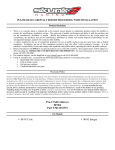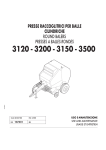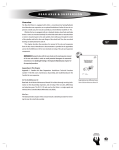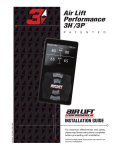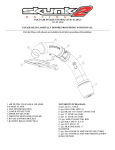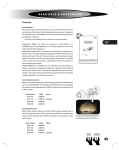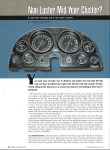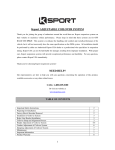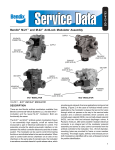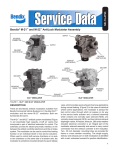Download HTSpec Damper Suppliment Doc
Transcript
For assistance, please call 949-295-1668 or visit heeltoeauto.com Support Documentation for HT-Spec Version 2.0 Type-I and Type-II Damper Kits HTSpec was launched in 2010 as a way for Heeltoe to convey a product’s viability to prospective customers. Items which have been proven to be the most reliable, most popular, and most effective will become HTSpec parts. Only items that are able to meet customer demands of improvement impact with minimal compromise are selected to represent this moniker. History: The HTSpec damper kit was released in late 2010 as a combined effort with Function/Form Autolife suspension. The main goals of most all Acura TSX and TL owners when it comes to upgrading suspension involve a uniform set of principles. Handling improvement to enhance driving confidence, vast height adjustment ability from a reasonable lowered height all the way to the ground, a ride that is not that of a track car and is suitable for a daily commute and affordability are all main targets that the HTSpec damper kit is designed to hit. After a hugely successful launch, the damper kits were re-evaluated and there were found to be some considerable improvements to the dampening that were needed in order to become more perfect. In June 2011, the HTSpec Version 2.0 damper kits were released. These dampers, while they looked the same on the outside, offering a more favorable front and rear valving balance. The ride has improved significantly, as has the handling sharpness. Another update came in the last quarter of 2011 when we elongated the lower brackets to allow for more height range adjustment. HTSpec coilovers of this latest release can achieve a stock height setting. In addition, the 03-07 Accord kits were added to the lineup. To this day, we have not seen any suspension kit come close to hitting all the main speaking points that the HTSpec V2 Damper kits do. Which Kit To Choose: There are two different types of HTSpec damper kits from which to choose. • • Type-I has adjustable height with a fixed ride setting Type-II has adjustable height and adjustable ride firmness Both kits offer the following features • • • Rubber upper mounts pre-installed Front/Rear spring rates: 12/6 kgf Adjustable lower bracket for increased height flexibility • • • 1 year warranty against defect Zinc plated bodies/collars for corrosion protection Full installation phone support from Heeltoe Installation: Because of the important role the suspension plays in the driving of your car, we recommend installation be done by a qualified individual. Your safety should be the first thing to think about before tackling any installation or repair job. If you are not completely confident that you can perform a trouble-free install, seek help or call us for advice. Adding HT-Spec Decal: HT-Spec damper kits come from the Function/Form factory preassembled and pre-packaged. When you get your HTSpec dampers you will want to add HT-Spec decals to distinguish them from standard Function/Form kits. Adjustment Of Preload and Lower Bracket Height: We have found that installation of this system does not prompt nearly as many questions as adjusting it does, so we have provided a more detailed section on adjusting in this document. The first and most important thing to realize about this kit is that the kit comes assembled but it is still a good idea to affirm measurements and snug hardware before installing. Here we will outline the different points of interest for you to review. There are 2 main measurements you need to take into account when adjusting coilvoers. Those are PRELOAD and the LOWER BRACKET HEIGHT. Preload: Preload is the length of the spring as mounted between the upper mount and the spring seat collars (note, this is not the same as spring free-length, which is the length of the un-installed spring). Since parts such as rubber bushings and spacers can distort over time we recommend measuring preload from the hard mounting points at the top and bottom of spring mount locations. On the HT-Spec dampers this is the bottom of the top mount, and the top of the lower spring seat. Preload is an adjustment that is used for adjusting the effective firmness of the spring. If you feel that the car’s springs are a little too soft but you don’t have the ability to change springs out for firmer ones, you can adjust the preload to make the spring act like a firmer one by compressing it with the seat collars. The drawback to adding preload is that you take away travel from the spring with can affect how the damper works with it. Also, the dampers are designed to work with a specific spring rate so dialing in preload can upset the tuning of the system. Adding too much preload can result in a suspension that is very non-compliant and potentially unsafe or damaging to the shock. However contrary to standard documentation provided with all Function/Form kits, altering the preload in prescribed increments will NOT void the warranty on your HTSpec damper set. When the preload length gets smaller, it is called adding preload. This is done by spinning the lower spring seat collars toward the top of the shock. When the lower collars are adjusted such that the spring if firmly mounted but it is not compressed at all, it is called ZERO PRELOAD. We generally recommend starting tuning from this point Adding • • • Adding • • • Preload Pros: Can make the spring feel firmer when needed to resist bottoming or float Gives more flexibility of suspension tuning Can be used to raise the car’s height a bit Preload Cons: Can increase ride firmness if not desired Too much can be damaging to the shocks Will change the car’s height (if you like your height now…you will need to make more adjustments to get back to it) Lower Bracket Height: The lower bracket height is in reference to the location of the lower mounting bracket as threaded onto the bottom of the shock, which is fully threaded on its full length. Unlike other systems that do not have this adjustment, HTSpec coilvers will have more flexibility of height adjustment independent of spring preload. Sometimes systems with a lower bracket height adjustment are called “full length” adjustable or said to have “independent height adjustment.” Since this setting is made AFTER preload is determined, it is usually easiest to call out this setting as the distance of threads showing between the lower spring seat collar and the lower bracket locking collar. The two biggest components of spring tuning functions are getting the rates set and setting the vehicle height. The correct spring rates will help balance the car and aid stability when pushing hard. The vehicle height is mostly responsible for affecting the balance of the car and the center of gravity. A process known as corner weighting is used to tell tuners how much weight is being supported at each corner of the car. Lower corners of the car will have a greater weight bias, and higher corners will have a lower weight bias. Since setting preload can change the height of the car at a given corner, having the ability to set the height back to an ideal corner-weight is necessary. Hence, the benefit of full length adjustment dampers; they allow setting of preload for the best spring tuning, while also allowing corner-weighting to give the best balance. This setup has been adopted by street tuners because they will allow setting the height of the car without messing with preload and negatively impacting the ride. Street tuners want lower cars without ride compromise and this setup allows this. HT-Spec damper kits are able to lower cars so low they will be practically un-drivable. However the added benefit of adjustment in HT-Spec damper kits enable a nearly stock height as well, as many drivers prefer not to lower too much to make commuting difficult. Making Lower Bracket Height smaller will lower the car while making it larger raises it. Lower • • • Lower • • • Bracket Height Adjustment Pros: Allows independent setting of preload and corner-weight for best performance Allows large range in vehicle height settings Manufacturing costs can be reduced allowing lower cost kits for street tuners. Bracket Height Adjustment Cons: Makes setting height a little more difficult since it is less conventional that “normal” coilovers Allows people to lower cars to an unsafe ride height Not all systems like this are created equally but people tend to lump them all into one category (these are performance settings, but not all kits are made for performance as some are quite cheaply made) Recommended Height Settings for HT-Spec Dampers: Front Rear Preload Lower Bracket Height Resulting Vehicle Height* Preload Lower Bracket Height Resulting Vehicle Height* 7-1/2" 3-3/4” 13-3/4" 8-3/4" 4-1/2" 14" 7.5" 3-7/8" 14-1/4" 8-3/4" 4-5/8" 14-1/4" TDB TDB TDB TDB TDB TDB 04-08 TSX 04-08 TL 03-07 Accord *For vehicle height measurement standard, please visit this site: http://www.heeltoeauto.com/tech-articles/suspension/how-to-measure-your-cars-height.html Note that the above figures are for reference only and your car may require additional adjustment to achieve ideal settings. Use the following form to help you in determining How to use form: 1) Fill in Before Height and Desired Height. Leave Blue Fields Alone. 2) Perform Work On Car 3) Fill In After Height To Determine If Goal For Height Change Is Met. Height of car Front Left Before Desired Height Adjustment Needed After Actual Change Rear Right Left Right Setting the max high: Sometimes customers will want to set the coilovers as high as they can go. There is a minimum amount of threads from the shock that need to be spun into the lower bracket, about ½”. This is how you would accomplish this. 1. Spin the lower bracket completely off. 2. Move the lower bracket locking ring down so ½” of threads are showing, as below: 3. Reinstall lower bracket and tighten locking collar. a. Note, max high will not necessarily set front and rear levels even. Adjusting the ride firmness (Type-II only): The Type-II Kit offers the ability to change the damper firmness for improved ride and handling customization • • Improve the ride comfort buy softening dampers o To make the car fell less like it is “crashing” over bumps, soften the front o To make the overall ride more comfortable, soften the rear Enhance the performance and handling of the car o For sharper, more direct steering feel and car control, firm up the front o For better handling in tighter, slower corners, firm up the rear The damper kit will come with 4 adjustment knobs that need to be installed on the tops of the shocks. Simply screw them on and gently snug them with pliers. DO NOT MAKE THEM TIGHT OR OVERTIGHTEN THEM. Tightening locking collars: Spanner wrenches are included in each kit for tightening the spring seats/locking collars. While these tools are good for grabbing and turning the collars, they may not provide enough torque to adequately lock them in place. For adequate tightening to lock collars in place, we suggest using a hammer and punch/screwdriver to tighten locking rings. You can also use a hammer on the spanner wrenches. The space requirements in the area of the car you are working in will dictate the best technique to use. Torque settings for hardware (top hat nuts, suspension assembly nuts and bolts): All nuts and bolts used for mounting and assembly should be adjusted to the same torque as OEM hardware. Consult the OEM service manual for these torque values. Failure to ensure proper tightness of hardware could result in movement of the suspension components and impact the long-term settings of the suspension. Noises can also occur while driving. Avoidance of problems is a main reason why a qualified person should be doing installation on critical suspension parts. Corrosion protection and long term care: To protect from corrosion, it is best to apply a protective layer to outside of the coilover threads and adjustment points. We’ve seen people wrap the threads with tape or other covering but we do not recommend this as water can get in and be held in place increasing problems. It is best to simply spray the components down with a light coating of penetrating lubricant or WD-40. This petroleum based layer will repel water and prevent dirt from attacking the material. Periodic cleaning and reapplication should keep your coilovers corrosion free. Troubleshooting: Problem Variables and Causes Corrective Action Noise Occurrence Squeaking sounds Cause by rubbing issues. Check mounting of the spring in the seats. Ensure there are no parts contacting each other that can rub together. Also check the condition and tightness of sway bar bushings. Lube if necessary Some faint noises heard over bumps are not indicative of installation issues in most cases and can be considered normal. Double-checking installation and emptying out contents of the car can help determine if the noise is related to the suspension. Most likely there is an issue with the installation. Sway bar links are most commonly left loose and must be tightened properly, or possibly replaced if proper tightening is not achievable. If the noise moves with the suspension, consult Heeltoe for advice. If the noise stays on the original side after swapping, inspect other areas of the suspenion or car for issues as the noise is not related to the damper assembly. If the noise goes away, you had an installation issue that is now resolved. If the car is too low, the upper control arms will contact the inner wheel houses. This problem is especially worse if Ingalls or SPC camber ball joints are installed. If installed, swap parts for Skunk2 camber arms. Raise car as necessary. Add preload. If your preload setting is 8” from the upper mount to the base of the spring, move it to 7.5” Faint clunking over minor bumps Medium volume clunking or tapping Persistent prominent clunking noises from one side of the car Swap suspension from left to right Loud Banging from the front over bumps Car is too low (usually 3" or more, tucking tires) Not enough preload is dialed in, especially in the front. Uncomfortable ride With Type-II Suspension Adjusting knob click issues Spins only, no clicking Spins forever without stopping Ensure the preload is set to zero or is per the adjustment outlined by Heeltoe, and set dampening softer in the rear. The knob is broken. Contact us for a replacement The knob is broken. Contact us for a replacement Warranty Information HTSpec Damper Kits are produced by Function/Form Autolife and they have established a warranty . This is 1 year from the date of purchase against general manufacturer defects. For complete warranty coverage details, please visit: http://www.f2autolife.com/warranty-policy A warranty card is included with the HTSpec damper kits which should be mailed in to Function/Form in order to register the product and establish the date when warranty coverage begins. It is important to note on the warranty card your suspension is “HTSpec” suspension! Note: resetting preload WILL NOT void the warranty. Warranty claims must be pursued by the customer through Function/Form via the link/warranty card information above. Heeltoe is not incurring warranty expenses. However, in an effort to ensure the best possible customer experience, Heeltoe encourages all problems and concerns be communicated to [email protected] so we may assist in any general service issues you have!









